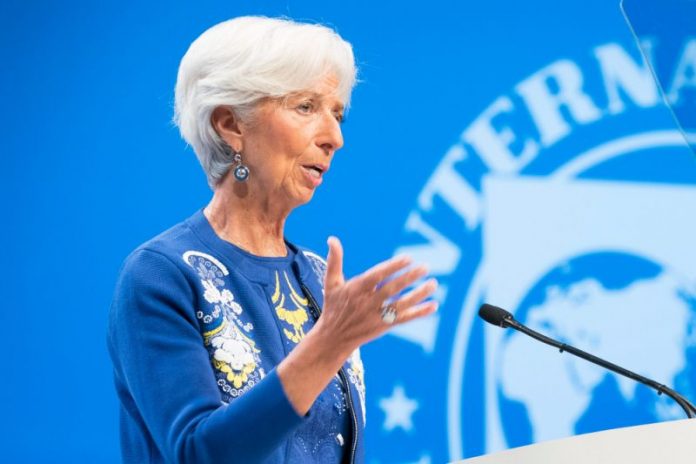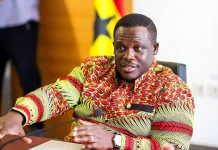
The Managing Director of the International Monetary Fund (IMF), Ms Christine Lagarde, has observed that the Ghanaian economy is in a better place than it was two years ago.
She said the IMF-supported programme had been an anchor for orderly economic adjustment and a positive signal to the market.
During that period, Ms Lagarde said, the Ghanaian authorities had made important gains towards macroeconomic stability, including inflation, which had declined to a single digit and now within the Bank of Ghana’s (BoG’s) tolerance band; buoyant growth, averaging about five per cent between 2015 and 2018 (and over six per cent in 2017-18) and a primary surplus in 2017 for the first time in 15 years.
In an email response to the Daily Graphic’s questions ahead of her maiden visit to Ghana yesterday, Ms Lagarde said the programme, which ends this December, served as “an anchor for orderly economic adjustment and a positive signal to the market”.
She underscored the need for Ghana “to preserve those gains” for the progress of the country and the citizens in particular.
The IMF, founded in 1945, is a global body of 189-member countries, including Ghana.
Extended Credit Facility
The IMF’s Extended Credit Facility (ECF) provides financial assistance for countries with protracted balance of payment problems.
In 2015, the Ghana government entered into an agreement with the IMF for economic assistance.
The deal concluded with a funding support of $918 million to be disbursed to Ghana under eight tranches.
Some key issues of the credit facility included the freezing of public sector employment, reducing the budget deficit and zero financing of the budget deficit by the BoG.
Future of work
Ms Lagarde is due to open a regional conference on the “Future of Work in sub-Saharan Africa (SSA)” in Accra today December 17, 2018.
Her visit comes at a time ECF programme, signed in 2015, is nearing its completion.
The government has already announced its decision to exit on completion, after extending it by some six months.
Ms Lagarde said being under the IMF provided the anchor for orderly economic adjustment and that sent a positive signal to the market. Although Ghana planned to exit the programme, she said, it was important to continue on that positive pedestal.
Needed reforms
Although the country has undertaken several structural reforms under the IMF programme, the pace has been slower and, according to Ms Lagarde, challenges still persisted.
Ghana has undertaken several important structural reforms, including adopting a Public Financial Management Act, improving debt management and strengthening the banking sector, including through the resolution of insolvent institutions.
“At the same time, a number of challenges still have to be tackled, including a large debt stock, low revenue base, large non-performing loans, fragilities in the financial sector and a still relatively low level of foreign exchange reserves.
“Important gains towards macroeconomic stability have been achieved and should be preserved through the implementation of responsible macroeconomic policies and structural reforms. These will take time, and the authorities have expressed a commitment to continue to pursue them,” she explained.
Post-IMF exit
She also added that the IMF would continue to have regular policy dialogues with Ghana through annual discussions in the context of Article IV consultations.
The IMF, she said, remained committed to supporting Ghana’s development strategy and contributing to capacity development, which had been facilitated by its technical assistance centre located in Accra.
Below are excerpts of the responses given by Ms Lagarde to questions posed to her by the Daily Graphic (DG)
DG: Ghana’s ongoing Extended Credit Facility (ECF) programme with the fund is nearing its completion. How would you rate its success to date, vis-à-vis the objectives that were set at the beginning?
CL: The Ghanaian economy is in a better place than it was two years ago. The IMF-supported programme has been an anchor for orderly economic adjustment and a positive signal to the market. During that period, the Ghanaian authorities have made important gains towards macroeconomic stability, including inflation declining to a single digit and now within the Bank of Ghana’s tolerance band; buoyant growth, averaging about five per cent between 2015 and 2018 (and over six per cent in 2017-18) and a primary surplus in 2017 for the first time in 15 years.
It will be important to preserve these gains.
DG: As with many past programmes between Ghana and the fund, the structural reform agenda has proceeded at a slower pace than contemplated. What arethe outstanding reform areas that the country must focus on after the completion of the programme, and how can the reform momentum be sustained?
CL: The Ghanaian authorities have undertaken several important structural reforms, including adopting a Public Financial Management Act, improving debt management and strengthening the banking sector (including through the resolution of insolvent institutions). At the same time, a number of challenges still have to be tackled, including a large debt stock, low revenue base, large non-performing loans, fragilities in the financial sector and still relatively low levels of foreign exchange reserves.
Important gains towards macroeconomic stability have been achieved and should be preserved through the implementation of responsible macroeconomic policies and structural reforms. These will take time, and the authorities have expressed a commitment to continue to pursue them.
DG: What sort of relationship will exist between the fund and Ghana after the programme, and have you had any discussions with the government on this subject?
CL: As with all IMF members, we will continue to have regular policy dialogues with Ghana through annual discussions in the context of the Article IV consultations. The fund remains committed to continuing to support President Nana Addo Dankwa Akufo-Addo’s development strategy. We will also continue to support Ghana through capacity development which has been facilitated by the technical assistance centre we have in Accra.
DG: Sub-Saharan Africa (SSA) has manifold development problems, including low domestic resource mobilisation, inadequate infrastructure, poor agricultural performance, poor quality public services, unemployment, etc, and opinions vary on which of these is/are the most pressing or challenging for the region. Is the decision of the fund to organise a conference on the future of work in SSA an indication that you consider the issue of work/(un)employment to be the most pressing of the region’s challenges? Why or why not?
CL: Let me start by emphasising that during the past two decades, sub-Saharan Africa created nine million new jobs per year, keeping up with population growth. As a result, the share of the population living in extreme poverty declined to 41 per cent in 2015 from 59 per cent in 1993.
However, even faster progress will be needed over the next two decades, as sub-Saharan Africa’s labour force is projected to grow at twice the rate of the last decade. Twenty million jobs will have to be created every year during that time frame to provide employment opportunities for young labour market entrants.
Additionally, technological advances are fundamentally changing the world of work, with technology allowing us to do things better and taking over tasks previously done by humans. Thus technology offers opportunities for leapfrogging infrastructure that is becoming outdated, but also raises concerns about the disappearance of some existing jobs.
We are organising this conference to foster discussions on the policies needed to address these challenges and enable the strong creation of high-quality jobs in sub-Saharan Africa.
DG: The background to the conference is the October 2018 Regional Economic Outlook on Sub-Saharan Africa publication and other research by the fund on the future of work in SSA. What exactly are the findings that you have made on the subject?
CL: Over the last centuries, three industrial revolutions have fundamentally changed the way we work, the way we live. The introduction of the steam engine, electricity and computers has made humans more productive and yielded unprecedented improvement in living standards.
We are now looking at a new revolution led by technological advances, in part driven by machines starting to work and think by themselves, the so=called artificial intelligence.
Graphic.























